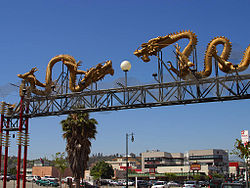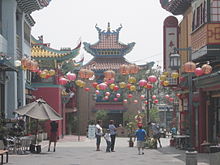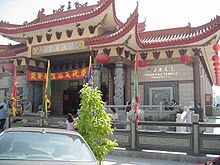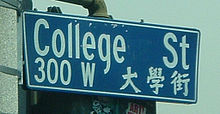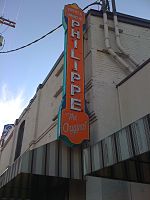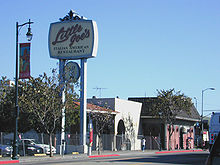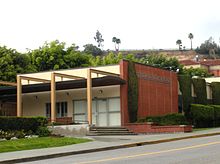- Chinatown, Los Angeles
-
Chinatown — Neighborhood of Los Angeles — Official entrance to Los Angeles' Chinatown Location within Downtown Los Angeles Coordinates: 34°03′46″N 118°14′16″W / 34.062888°N 118.23789°W Country  United States
United StatesState  California
CaliforniaCounty County of Los Angeles City  Los Angeles
Los AngelesGovernment - City Council Jose Huizar - State Assembly Anthony Portantino (D) - State Senate Gilbert Cedillo (D) - U.S. House Lucille Roybal-Allard (D) Area - Total 2.3 km2 (0.9 sq mi) Population (2008)[1] - Total 28,839 - Density 8,693.1/km2 (22,515/sq mi) ZIP Code 90012 Area code(s) 213 Website chinatownla.com Chinatown in Los Angeles, California (Chinese: 洛杉磯唐人街; pinyin: luò shān jī táng rén jiē) is located in the city's downtown area. Built in 1938, it is the second Chinatown to be constructed in Los Angeles. The original historic Chinatown was founded in the late 19th century, but was demolished to make room for Union Station, the city's major rail depot, leaving its residents and businesses displaced.[2][3] It is one of three current major Chinatowns in California; one in San Francisco and the other being in Oakland.
Contents
History
Old Chinatown
The first Chinatown, centered around Alameda and Macy Streets, was established in 1880. Residents were evicted to make room for Union Station, causing the formation of the 'New Chinatown."[3][4]
In 1871, 19 Chinese men and boys were killed by a mob of 500 locals in one of the most serious incidents of racial violence that has ever occurred in America's West. This incident became known as "Massacre of 1871".
Reaching its heyday from 1890 to 1910, Chinatown grew to approximately 15 streets and alleys containing 200 buildings. It was large enough to boast a Chinese Opera theatre, three temples, its own newspaper, and a telephone exchange. But laws prohibiting most Chinese from citizenship and property ownership, and Exclusion Acts curtailing immigration, inhibited future growth for the district.[5]
From the early 1910s Chinatown began to decline. Symptoms of a corrupt Los Angeles discolored the public's view of Chinatown; gambling houses, opium dens, and a fierce tong warfare severely reduced business in the area. As tenants and lessees rather than outright owners, the residents of Old Chinatown were threatened with impending redevelopment and as a result the owners neglected upkeep on their buildings.[3] Eventually, the entire area was sold and resold, as entrepreneurs and town developers fought over usage of the area. After 30 years of continual decay, a Supreme Court ruling approved condemnation of the entire area to allow for the construction of the new major rail terminal, Union Station.[3][6]
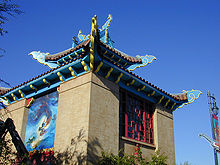 The dragon mural in L.A. Chinatown painted by Tyrus Wong and restored by Fu Ding Cheng (1984)
The dragon mural in L.A. Chinatown painted by Tyrus Wong and restored by Fu Ding Cheng (1984)
Seven years passed before an acceptable relocation proposal was put into place, situating Chinatown in its present day location.[3] During that long hiatus, the entire area of Old Chinatown was demolished, leaving many businesses without a location, and forcing some of them to close permanently. Nonetheless, it is not commonly known that a remnant of Old Chinatown persisted into the early 1950s, situated between Union Station and the Old Plaza. Several businesses and a Buddhist temple lined Ferguson Alley, a narrow one-block street running between the Plaza and Alameda. As late as 1951, the remaining structures on the east side of the Plaza included the Lugo House, originally built in 1838 as their townhouse by the prominent Californio family. In later years it was used as the original location of St. Vincent's College, which ultimately became Loyola Marymount University, now located in Westchester. Later still, the Lugo House was rented out to Chinese-American tenants who operated shops on the ground floor, and a lodging house upstairs. Christine Sterling, who had worked so tirelessly to bring about the conversion of the Olvera alley into a tourist oriented imitation of a Mexican marketplace, was far less enamored of the Chinese American contributions to the city's history.[7] One reason for this was that she considered the remaining buildings of Old Chinatown, and the businesses and cheap lodgings they contained, to be an eyesore. However, more importantly, she wanted the Plaza neighborhood to stand as a monument to the city's Mexican American heritage exclusively; allowing the Chinese to remain along the east edge of the Plaza would have detracted from that. Instead, she advocated the razing of all the remaining structures between the Plaza and Union Station for use as a parking lot.[8] In the late 1950s the covenants on the use and ownership of property were removed, allowing Chinese Americans to live in other neighborhoods and gain access to new types of employment.[9]
"The original Chinatown's only remaining edifice is the two-story Garnier Building, once a residence and meeting place for immigrant Chinese," according to Angels Walk – Union Station/El Pueblo/Little Tokyo/Civic Center guide book. The Chinese American Museum is now located in Garnier Building.[3]
New Chinatown
The area that today encompasses New Chinatown was originally Los Angeles' Little Italy. In the early 20th century, Italian immigrants settled in the area north of the Old Plaza. Many built businesses, including wineries (San Antonio Winery is the only one of these still in existence).[10] In the 1920s and 30s, Italians began moving out of Little Italy to elsewhere in the city. When the Italians moved out, the Chinese began moving in.
In the 1930s, under the efforts of Chinese American community leader Peter Soo Hoo Sr., the design and operational concepts for a New Chinatown evolved through the collective community process, resulting in a blend of both Chinese and American architecture. The Los Angeles Chinatown saw major development, especially as a tourist attraction, throughout the 1930s with the development of the "Central Plaza", a Hollywoodized version of Shanghai, containing names such as Bamboo Lane, Gin Ling Way and Chung King Road (named after the city of Chongqing in mainland China). Chinatown was designed by Hollywood film set designers and a "Chinese" movie prop was subsequently donated by the legendary film director Cecil B. DeMille to give Chinatown an exotic atmosphere.[citation needed] Today, this section of Chinatown is less frequented by ethnic Chinese residents and dayshoppers, though it is where several benevolent associations are located. Chinatown expanded beyond the area and is now bounded by Cesar Chavez Avenue and Dodger Stadium.
Many of the older buildings built in the 1930s and 1940s in the northeast corner of New Chinatown (near the Pasadena Freeway) were previously abandoned. As part of gentrification movement, they are now primarily used as art galleries by artists. It has also been turned into a center of nightlife.
There is relatively little social interaction between these artists and business owners and the Chinatown Chinese-speaking residents. Many elderly residents usually lounge in the court of Central Plaza. The historic Hop Sing Tong Society is located in Central Plaza, as are several other Chinatown lodges and guilds.
New Chinatown is served by the Gold Line of the city's Metro Rail; parts of Old Chinatown were uncovered during excavation for another portion of the L.A. subway (the Red Line connection to Union Station). The Metro Rail station in Chinatown has been designed with modernized traditional Chinese architecture.
Chinatown's residential areas are on the hills northwest of Alpine Park, with a public elementary school, library, Chinese school, hospital, churches, and other businesses. In the mornings at Alpine Recreation Center, many Chinese-speaking elders practice the relaxing t'ai chi, a scene common in many Chinatowns.[11]
This area is located a short distance from the main tourist areas. In 1996, an Academy Award-winning (for the Killing Fields in 1985) Cambodian refugee, physician and actor Haing S. Ngor was killed in the Chinatown residential area in a bungled robbery attempt by members of an Asian gang. It had been speculated that he was assassinated for his activism against the Khmer Rouge government of Cambodia but this was later proven unfounded.[12] After the release of ‘The Killing Fields,' Ngor had told the New York Times, "If I die from now on, okay! This film will go on for a hundred years."
 Sculpture of Sun Yat-sen in Chinatown.
Sculpture of Sun Yat-sen in Chinatown.
Near Broadway, Central Plaza contains a statue honoring Dr. Sun Yat-sen, a Mainland Chinese revolutionary leader who is considered the "founder of modern China". This unique monument was erected in the 1960s by the Chinese Consolidated Benevolent Association.
During the 1980s, many buildings were constructed for new shopping centers and mini-malls, especially along Broadway, and this would expand Chinatown greatly. In the mid-1990s, a new shopping center containing a 99 Ranch Market was built near the old Central Plaza. However, the supermarket failed, and closed its doors a few years later in 1997. (The chain is highly successful, however, in the numerous Chinese communities of the San Gabriel Valley.) Metro Plaza Hotel was built in the southwest corner of Chinatown in the early 1990s but it has struggled with a low occupancy rate. A large Chinese gateway is found at the intersection of Broadway and Cesar E. Chavez Avenue. This was funded by the local Teochew-speaking population.[citation needed]
By 2000 many people had left the Chinatown for the City of Monterey Park, which has a Chinese community. In 2000 AsianWeek said that the Los Angeles Chinatown was "troubled."[13]
On June 28, 2008, a celebration of the 1938 founding of New Chinatown was held with the L.A. Chinatown 70th Anniversary Party.[14] "Though lacking the hustle and bustle of San Francisco's Chinatown, Los Angeles' version has charms of its own."[15] It attracts visitors from throughout the Los Angeles area and all over the world. However, there are many businesses in Chinatown that cater mainly to the local community rather than the tourism economy.
New ethnic Chinese immigrants
Thien Hau Temple, another popular attraction in LA Chinatown.
As in most other Chinatowns in the United States, Taishanese (or Toisan)–a subdialect of Cantonese–was the dominant Chinese dialect of the Los Angeles Chinatown until the 1970s. In post-Vietnam War 1970s, some members of the Los Angeles lodge of the Chinese Consolidated Benevolent Association headed to the Vietnamese refugee settlements in Camp Pendelton to talk and entice several refugees - especially ethnic Chinese from Vietnam - into settling into the once-diminishing Chinatown by sponsoring them. Thus, during the 1980s, Cantonese and especially Teochew (Pinyin: Chaozhou, Vietnamese: Trieu Chau) Chinese became more widely spoken as Chinatown experienced a rise in Vietnamese and Cambodians and Thais. While Cantonese is still predominant and remains the lingua franca of Chinatown, the use of Taishanese has diminished in Los Angeles and its usage is more common among elderly Chinese within the area.
With the boom of de facto suburban Chinese communities in the eastern part of the Los Angeles area, there have been very few immigrants from the Republic of China - especially those with high socioeconomic status - to the downtown Chinatown. Mandarin is only used in some contexts in Chinatown and is not widely spoken there.
The arrival of new immigrants from Southeast Asia and Mainland China to Los Angeles Chinatown gave rise to new associations such as the Southern California Teo Chew Association (serving the Teochew speakers), the Cambodia Ethnic Chinese Association (catering to Chinese Cambodian residents), the Camau Association of America (service immigrants from the Camau Province of Vietnam), the Southern California Fukienese Association and the Foo Chow Natives Benevolent Association (both serving immigrants from the Fujian province of Mainland China).[4]
Many Vietnamese and Cambodian immigrants in the downtown Chinatown run small curiosity shops and bazaars in the shopping plazas such as Saigon Plaza and Dynasty Center—both built in the 1980s—south of Broadway. Today these immigrants and their families own nearly 90 percent of Chinatown's businesses. Most old-time Chinese American (those of Taishanese and Cantonese descent) businesses are located in the old Chinatown Plaza.
Geography
The main streets running through the new Chinatown are Broadway, Spring Street and Hill Street. Chinatown is located directly north of downtown Los Angeles, between Dodger Stadium and the Los Angeles Civic Center. The Broadway side of Chinatown is usually packed with myriad tourists, with a lot of Chinese restaurants and merchants.
Chinatown is somewhat segregated between Chinese ethnic groups in some respects. College Street, running in a northwest-southeast direction, provides a rough boundary between the older (post-1930s and 1940s) and newer businesses (post-1980s). Many businesses belonging to the original American-born Chinese families (Taishanese and Cantonese) are in the northwest area. Also due to the stylized exotic atmosphere, this section of Chinatown is very popular for on-site movie filming, such as Rush Hour with Jackie Chan. In the southwest, according to an estimate in the Los Angeles Times, nearly 90% of businesses are owned by first-generation Southeast Asian immigrants and refugees of Chinese origin.
Businesses
Retail
There are numerous small, specialized grocery stores in Chinatown. The Chinese Vietnamese own many bazaars. The stores sell products such as soap, toys, clothes, music CDs at low prices. Several restaurants in Chinatown serve mainly Cantonese cuisine but there are also various Asian cuisine restaurants such as Teochew Chinese, Vietnamese, Indonesian, and Thai, which reflects the diverse character of Chinatown. Many Chinatown-area restaurants have been featured and reviewed extensively in the Food section of the Los Angeles Times. Few boba cafes have opened in Chinatown, but a large number are to be found in the "suburban Chinatowns" of the San Gabriel Valley.
 A feng shui spiral at Chinatown's Metro station.
A feng shui spiral at Chinatown's Metro station.
TS Emporium, Wing Hop Fung, and Tin Bo are stores selling ginseng and herbs as well as other household merchandises are operated within the confinement of this particular Chinatown.
Dynasty Center, Saigon Plaza, and the Chinatown Phuoc Loc Tho Center feature many Vietnamese-style bazaars with people engaged in bargain shopping for items such as clothing, toys, Chinese-language CDs, pets, household items, funerary products, and so on. Its entrepreneurs are ethnic Chinese from Vietnam.
There are over 20 art galleries to see, mostly featuring non-Chinese modern art, with works from up and coming artists in all types of media. Popular galleries include Acuna-Hansen Gallery, Black Dragon Society, China Art Objects, and The Gallery at General Lee's. Spaces such as Telic Art Exchange, Betalevel and The Mountain Bar often have readings, performances and lectures.
Restaurants
Chinatown offers the usual barbecue delicatessens - with glass displays of roast duck and suckling pig - and Cantonese seafood restaurants with dim sum. Owing to its large Vietnamese influence, there are many eateries in Chinatown offering Vietnamese pho noodle soup and submarine sandwiches called banh mi as well.
Plum Tree Inn is a restaurant serving Americanized Chinese cuisine. Similarly, Yang Chow Restaurant serves very Americanized Mandarin and Szechuan cuisine and is famous for its "slippery shrimp". Lucky Deli is among the more historic and popular Chinese food delicatessens, offering Chinese food at bargain prices.
Los Angeles Chinatown is home to the first restaurant of the venerable barbecue restaurant chain Sam Woo BBQ Restaurant, serving up Cantonese cuisine. Mein Nghia, a small local chain serving Teochew noodles which also operates in the new Chinatowns of San Gabriel Valley, started out in Chinatown as well. There are also a number of bakeries operating in Chinatown, such as Queen's Bakery and the much older Phoenix Bakery.
Some Chinatown restaurants that have attained good reviews include CBS Seafood Restaurant, Hop Woo Restaurant, Ocean Seafood Restaurant, and Empress Pavilion. Both CBS Seafood Restaurant and Empress Pavilion, two of the larger restaurants in Chinatown, are usually packed with customers waiting for a table for dim sum. Hop Woo, while touristy in atmosphere with Chinese lanterns and with waitresses dressed in cheongsam attire, offers both authentic and Americanized Chinese dishes. Ocean Seafood Restaurant has been Zagat Rated for six consecutive years, and it is widely known for its dim sum.[16]
Two of Chinatown's best-known restaurants do not serve Chinese food.[17] Phillipe's has been located on the corner of Alameda Street, at the edge of Chinatown, in the Historical District of Los Angeles since 1951,[18] and is known as one of the creators of the French Dip sandwich.[18] Little Joe's Italian American Restaurant, now closed, has long stood at the corner of Broadway and College Street. Little Joe's began in 1897 as the Italian-American Grocery Co. by Charley Viotto, an Italian immigrant.[19] When Italy sided against the U.S. in World War II the Italian-American Grocery Company became Little Joe's.[20] It was a popular place for the lunch crowd from the Civic Center and Dodger Stadium (including Tommy Lasorda).[21] The business passed down to the founder's great-grandson, who said it was the oldest family owned business in the city.[19] It closed in December 1998 due to the expense of retrofitting the building to meet earthquake standards.[19] The interior was left unchanged and it has been used as a filming location.[22] 15 Minutes, which starred Robert De Niro, was filmed there.
Government and infrastructure
Los Angeles Fire Department Station 4 is in Chinatown.
Education
Residents in Chinatown are zoned to Los Angeles Unified School District schools:
- Castelar Elementary School
- Nightingale Middle School
- Belmont High School
- Miguel Contreras Learning Complex
- Lincoln High School
- Evans Community Adult School - largest stand-alone ESL adult school in the nation
- Edward R. Roybal Learning Center
- High School for the Visual and Performing Arts
- Cathedral High School, Private Catholic Boy's School, just down the hill from Dodger Stadium, is located on the north side of Chinatown. The mission of Cathedral High School is to provide a human, religious, and academic education to young men, especially those form economically poor families. [1]
Los Angeles Public Library operates the Chinatown Branch and the nearby Lincoln Heights Branch and Little Tokyo Branch. The Central Library is about seven blocks from Chinatown on South Grand Avenue.
Filming in Chinatown
Chinatown is also a popular location for filming. The haunting conclusion of the Academy Award-winning film Chinatown, starring Jack Nicholson and James Hong, was filmed on Spring Street.[23] The movie Rush Hour, starring Jackie Chan and Chris Tucker, was filmed on location in Chinatown.[24] A local Chinese restaurant featured in the film, Foo Chow Restaurant, mentions the fact on its wall sign. The filming location was also the Central Plaza. A stroll down Old Chinatown Plaza, has many rewards, including recognizing many other beautiful locations that are often used in filmmaking and television production.[25]
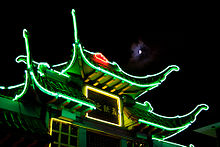 East Gate on Broadway in New Chinatown's Central Plaza, built in 1938, is Historic-Cultural Monument No. 826. West Gate on Hill Street is No. 825.
East Gate on Broadway in New Chinatown's Central Plaza, built in 1938, is Historic-Cultural Monument No. 826. West Gate on Hill Street is No. 825.
- Feature films
- Chinatown[23]
- 15 Minutes
- Balls of Fury
- Lethal Weapon 4
- Freaky Friday
- I Love You, Man[26]
- Rush Hour[27]
- Television
- Baywatch
- Beverly Hills 90210
- Hart to Hart
- Hunter
- JAG
- MacGyver
- Matlock
- Melrose Place
- Murder She Wrote
- Rockford Files
Notable residents
- James Hong (Chinese: 吳漢章), actor
- You Chung Hong (1898–1977), attorney, community leader[28]
- Haing S. Ngor (Chinese: 吳漢) (1940–1996), actor[29][30]
- Lisa See, author
- Robin Shou (Chinese: 仇雲波), actor
- Tyrus Wong (Chinese: 黃齊耀), artist
Events
- Chinese New Year 4709, Thursday, February 3, 2011 — Year of Rabbit
- Golden Dragon Chinese New Year Parade — Saturday, February 5, 2011, 1 pm (112th annual parade), Broadway and Hill Streets[31] (Actress Nancy Kwan was 2009 parade Grand Marshal)
- Chinese Lunar New Year Festival — Saturday, February 5, and Sunday, February 6, 2011
- Lantern Festival 2011 — Chinese American Museum, Saturday, March 5, 2011[32]
- Los Angeles Chinatown Firecracker 5k/10k Run, Kiddie Run, Fun Walk — Sunday, February 13, 2011[33]
- Lunar New Year Imperial Banquet — Friday, February 25, 2011
- Mid-Autumn Moon Festival — Saturday, September 25, 2010 5:30 pm - 10 pm[34]
- Miss Los Angeles Chinatown Pageant — Saturday, January 29, 2011, Hilton in Los Angeles/Universal City, 6:00 pm (Broadcast: Channel KSCI (LA18)[35]
- Jackie Chan & Friends Perform Free Concert in Chinatown — June 22, 2009, 6 - 7:30 pm (Chan sang the inspirational popular song “My Beloved Country”)
- 72nd Anniversary of New Chinatown — June 26, 2010, 7 pm - 11 pm[36]
See also
- List of Chinatowns
- Chinese American Museum
- Chinese Historical Society of Southern California
- Southern California Chinatowns
- KCET Departures interview with Munson Kwok Chinatown community leader
References
- ^ Chinatown Los Angeles
- ^ Angels Walk–Union Station/El Pueblo/Little Tokyo/Center, published by Angels Walk LA, 2000
- ^ a b c d e f Chinatown Los Angeles California, Restaurants in Chinatown, Pictures of Chinatown
- ^ a b Watanabe, Teresa (August 3, 2008). 1 First lady puts Thai Town on the map. Los Angeles Times.
- ^ See, Lisa (2003). Angels Walk - Chinatown. Angels Walk LA.
- ^ Cheng, Suellen; Kwok, Munson (June 1988). The Golden Years of Los Angeles Chinatown: The Beginning. The Los Angeles Chinatown 50th Year Guidebook.
- ^ William D. Estrada. The Los Angeles Plaza: Sacred And Contested Space.. University of Texas Press, 2008. p242.
- ^ Ibid., p244
- ^ Smith, Icy; Wang, Emily (2001). The lonely queue: the forgotten history of the courageous Chinese Americans in Los Angeles. East West Discovery Press. ISBN 978-0970165411.
- ^ "Italians in Los Angeles". p. 7-8. http://books.google.com/books?id=MwQZUOiSqPcC&printsec=frontcover&dq=%22little+italy%22+%22los+angeles%22&hl=en&ei=0XLETezyKILpgQeWwaXMBA&sa=X&oi=book_result&ct=result&resnum=9&ved=0CFUQ6AEwCA#v=onepage&q=%22little%20italy%22%20%22los%20angeles%22&f=false.
- ^ Alpine Park Center in New York, NY | New York Alpine Park Center - YP.COM
- ^ "Articles about Haing S Ngor - Los Angeles Times". Los Angeles Times. http://articles.latimes.com/keyword/haing-s-ngor.
- ^ AsianWeek Staff and Associated Press. "Philadelphia Chinatown Wins Stadium Fight. AsianWeek. November 24-30, 2000. Retrieved on November 8, 2011.
- ^ 70th Anniversary of New Chinatown, Chinatown Business Improvement District, June 28, 2008
- ^ Balfour, Amy C.: "Lonely Planet Los Angeles Encounter Guide 2nd Ed.", pag 130. Lonely Planet Publications PTY, 2009 LTD
- ^ Riehle, Ruth, "Grab that cart!" Los Angeles Times 13 January 1991: 95.
- ^ STEIN, PAT (February 12, 1998). "Can you do downtown L.A. on foot? You betcha!". The San Diego Union - Tribune: p. NIGHT.D.
- ^ a b Thursby, Keith (2010-02-09). "William 'Bill' Binder dies at 94; ran Philippe's eatery". Los Angeles Times. http://articles.latimes.com/2010/feb/09/local/la-me-bill-binder9-2010feb09. Retrieved 2010-02-26.
- ^ a b c POOL, BOB (October 8, 1998). "After Many Years, Little Joe's Will Just Fade Away". Los Angeles Times: p. 1.
- ^ "Little Italy hidden in L.A.'s tangled roots". Daily News (Los Angeles, Calif.): p. A.2. October 10, 2010.
- ^ Vincent, Roger (March 7, 2009). "REDEVELOPMENT; Chinatown project is halted; A bankruptcy stalls a complex planned for the Little Joe's site.". Los Angeles Times: p. B.1.
- ^ Mallory., Michael (December 2, 2002). "They're empty, but full of promise; Renting out vacant buildings as film locations can fill the needs of owners, production companies and the community.". Los Angeles Times: p. E.6.
- ^ a b http://www.movie-locations.com/movies/c/chinatown.html
- ^ Los Angeles Chinatown Restaurants Shops Sightseeing
- ^ http://www.hollywoodusa.co.uk/FilmLocations/chinatown.htm
- ^ http://www.seeing-stars.com/Locations/ILoveYouMan2.shtml
- ^ Los Angeles Chinatown Restaurants Shops Sightseeing
- ^ Los Angeles Chinatown Visitor Map, Chinatown B.I.D, 2006
- ^ My-Thuan Tran, Revisiting Haing Ngor's murder: 'Killing Fields' theory won't die, Los Angeles Times, January 21, 2010
- ^ Jim Hill, Actor Haing Ngor found gunned down outside L.A. home, CNN, February 27, 1996
- ^ Los Angeles Golden Dragon Parade
- ^ Chinese American Museum Events list
- ^ Firecracker Run Committee
- ^ Calendar, Chinese Chamber of Commerce
- ^ Miss L.A. Chinatown website
- ^ Chinatown Los Angeles events
- American Chinatown: A People's History of Five Neighborhoods, Bonnie Tsui, 2009 ISBN 978-1416557234 Official website
External links
- Los Angeles Chinese American Museum
- Los Angeles Chinatown Firecracker Run
- Chinese Historical Society of Southern California (Los Angeles Chinatown)
- Chinese Chamber of Commerce of Los Angeles
- Los Angeles Chinatown Business Council Official Website
- KCET Departures interview with Munson Kwok Chinatown community leader

Elysian Park 

Echo Park, Los Angeles  Chinatown, Los Angeles
Chinatown, Los Angeles 
Mission Junction, Los Angeles 
Civic Center, Los Angeles Los Angeles Plaza Historic District Chinatowns Africa South Africa: JohannesburgAsia India: Kolkata · Makum (closed) · Mumbai (closed), Indonesia: Jakarta, Iran: Mahale Chiniha, Japan: Kobe · Nagasaki · Yokohama, Malaysia: Kuala Lumpur, Myanmar: Yangon, Pakistan: Karachi, Philippines: Manila, Singapore Singapore, South Korea: Incheon, Thailand: Bangkok, United Arab Emirates: Dubai, Vietnam: Ho Chi Minh City (Saigon)Europe Latin America Argentina: Buenos Aires, Brazil: São Paulo, Costa Rica: San José, Cuba: Havana, Mexico: Mexicali · Mexico City, Peru: LimaNorth America Canada: Calgary · Edmonton · Lethbridge · Montreal · Ottawa · Toronto · Vancouver · Victoria · Winnipeg
United States: Boston · Brooklyn · Chicago · Cleveland · Flushing · Honolulu · Houston · Las Vegas · Los Angeles · Newark · New York · Oakland · Oklahoma City · Philadelphia · Portland · San Francisco · Seattle · Washington D.C.Oceania Downtown area, Los Angeles Districts and
neighborhoodsArts District · Bunker Hill · Chinatown · Civic Center · Fashion District · Financial District · Gallery Row · Historic Core · Jewelry District · Little Tokyo · Skid Row · South Park · Old Bank District · Toy District · Wholesale District

Points of
interestDowntown · Eastside/Northeast · Harbor Area · Greater Hollywood · Westlake/Silver Lake/Los Feliz · San Fernando and Crescenta Valleys · South Los Angeles · Westside · Wilshire
Coordinates: 34°03′46″N 118°14′16″W / 34.062888°N 118.23789°W
Categories:- Neighborhoods in Los Angeles, California
- Chinatowns in the United States
- Restaurant districts and streets
- Populated places established in 1938
Wikimedia Foundation. 2010.

